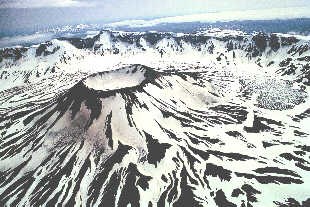
NPS Photo Midway down the wild and roadless Alaska Peninsula lies one of the Nation's most fascinating recent volcanic features. Aniakchak is a 6-mile-wide, 2,000-foot-deep caldera formed by the collapse of a 7,000-foot mountain. Lying inland in a region of frequent clouds and stormy weather, Aniakchak remained unknown to all but native inhabitants until the 1920s. Then, geographers remotely plotting mountain locations along the caldera's rim noticed their circular configuration. Eventually, in 1922, a geologic field party gazed down into the caldera. They brought back news of Aniakchak's immense proportions. Although a dozen calderas stand on the Alaska Peninsula, Aniakchak ranks among the largest. Its fascinating volcanic history can be read from its exposed internal plumbing. About 3,500 years ago, a dramatic explosion caused the loss of some 3,000 feet of the upper mountain. The remainder of the mountain then collapsed, leaving a relatively flat-floored, ash-filled bowl. Since the caldera first formed, many lesser eruptions have created the small cinder cones, lava flows, and explosion pits dotting its floor today. Wave-carved terraces high on the caldera wall indicate that the caldera once contained a deep snow-fed lake, much like Crater Lake in southern Oregon. However, hydraulic pressure or overflow eventually led to a breech of the caldera wall at a weak or low point. The result was a massive flood that created the great cleft through the caldera wall now known as The Gates. The Gates now allow the Aniakchak River to begin its tumultuous 27-mile course southeastward to the Pacific Ocean. Aniakchak's most recent volcanic activity came in 1931. A small but impressive explosion pit was added to the pockmarked caldera floor that year. Many thousands of tons of ash lay strewn within the caldera and scattered up to 40 miles away over the small villages. Fortunately, this volcanic episode was documented both before and after by an indomitable geologist and Jesuit priest, Father Bernard Hubbard. His photographs and descriptions provide an important benchmark for judging the likely rate of recovery of vegetation to the devastated caldera. Mosses, grasses, and more complex flowering plants have invaded sheltered spots. Brown bear and caribou have returned. Spawning runs of sockeye salmon now fight their way up the Aniakchak River and into Surprise Lake, the river's shallow headwater lake inside the caldera. In creating Aniakchak National Monument and Preserve, Congress recognized the unique geological significance of the caldera and also acknowledged the outstanding wildlife and recreational values of the Aniakchak River by designating it a wild river within the National Wild and Scenic Rivers System. The parklands boundaries also contain other important resources. West of the caldera lies the waterfowl and migratory bird habitat of Bristol Bay's coastal plain. To the east, rugged bays and inlets of the Pacific coast and offshore islands provide habitat for sea mammals and sea birds. Evidence of ancient human presence at Aniakchak is minimal. However, more may one day be known of this important transition zone between ancestral Aleuts and Yupik-speaking people.
Learn more about Aniakchak: Animals Plants Environmental Factors Natural Features & Ecosystems Research Species Lists |
Last updated: April 25, 2018
